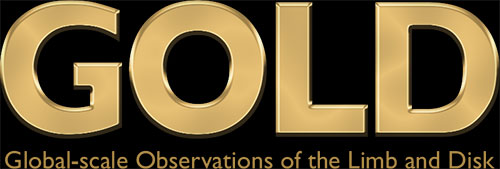
The GOLD instrument arrives in its shipping container at Airbus Defence & Space in Toulouse, France on January 4, 2017. Team members performed successful tests, inspection, and checkout of the instrument, which will next be mounted on the SES-14 commercial communications satellite that will carry GOLD for its planned two-year mission. (Courtesy Airbus)
A NASA instrument that will study the upper atmosphere and the impact of space weather on Earth is a step closer on its journey into space.
The Global-scale Observations of the Limb and Disk (GOLD) mission, led by University of Central Florida (UCF) scientist Richard Eastes, is scheduled to launch in late 2017 from Florida. Earlier this month, the LASP-built instrument was shipped to Airbus Defence and Space in Toulouse, France, for integration on the SES-14 communications satellite, on which it will be launched into space.
“I am excited to see GOLD take the next critical step in its journey toward providing scientists around the world with an unprecedented view of the Earth’s upper atmosphere, which will advance research for understanding space weather,” said Eastes, who is based at the Florida Space Institute at UCF.
Space weather can adversely affect technology and human activity in space, from disrupting communications systems to exposing astronauts to serious health risks.
“Space weather affects the satellites that we depend on for things like GPS and satellite TV; it affects the satellites themselves, as well as the signals they transmit,” Eastes said. “What we learn from GOLD’s images will help us understand how space weather changes during geomagnetic storms and how to avoid the problems that they cause.”
Joyce King is the mission manager for GOLD at NASA’s Goddard Space Flight Center in Greenbelt, Md.
“GOLD is one of several missions that is managed by the Explorers Program for NASA’s Heliophysics Division,” King said. “As NASA explores farther and farther from home, sending astronauts and spacecraft to distant places, we need better situational awareness about the space we’re traveling through. NASA studies the space environment around the sun, around planets, far into the solar system — and around Earth. GOLD focuses on the part near Earth.”
LASP, which has a seventy-year long history of providing instruments for NASA missions, built the GOLD instrument in collaboration with UCF. While weather satellites view clouds from geostationary orbit (an altitude of approximately 22,370 miles), GOLD will view a higher region of Earth’s upper atmosphere known as the thermosphere. This is a region (extending from approximately 55 to 500 miles altitude) where most satellites fly and through which the signals from all satellites pass.
Bill McClintock is a planetary scientist at LASP and GOLD deputy principal investigator.
“Today, NASA studies the thermosphere using spacecraft that give scientists intermittent views of the thermosphere. From those spacecraft it takes a day or more to build a global-scale image,” said McClintock. “The communication satellite carrying GOLD will be in geostationary orbit, meaning it will be fixed at one location above the Earth’s surface. This orbit enables GOLD to view nearly an entire hemisphere all the time. If a geomagnetic storm dumps energy into the thermosphere, we can watch the global-scale response on timescales of hours, rather than days. It’s a whole new way of looking at the dynamic behavior of the thermosphere.”
GOLD is a pathfinder for NASA’s use of commercial spacecraft for science missions. UCF and LASP partnered with SES Government Solutions (SES GS), based in Reston, Va., to provide GOLD with its ride into geostationary orbit on the SES-14 satellite that is owned and operated by SES, the parent company of SES GS.
Todd Gossett is the SES GS project manager for hosting GOLD on the SES-14 satellite.
“SES is honored to be a contributing member of the GOLD team. NASA’s concept to have missions such as GOLD hosted on commercially owned and operated satellites is a definite win, for not only the American taxpayer, but also for the science community,” Gossett said.
Rory Barrett is an engineer at LASP and the project manager for GOLD.
“We have assembled a world-class team to execute the GOLD mission. LASP has built and delivered one of its best performing science instruments, ever,” said Barrett. “Our strong partnership with SES GS and Airbus will enable a low-cost GOLD mission.”
Other members of the GOLD team include scientists from the National Center for Atmospheric Research, the University of California at Berkeley, Computational Physics Inc., and the National Oceanic and Atmospheric Administration.


